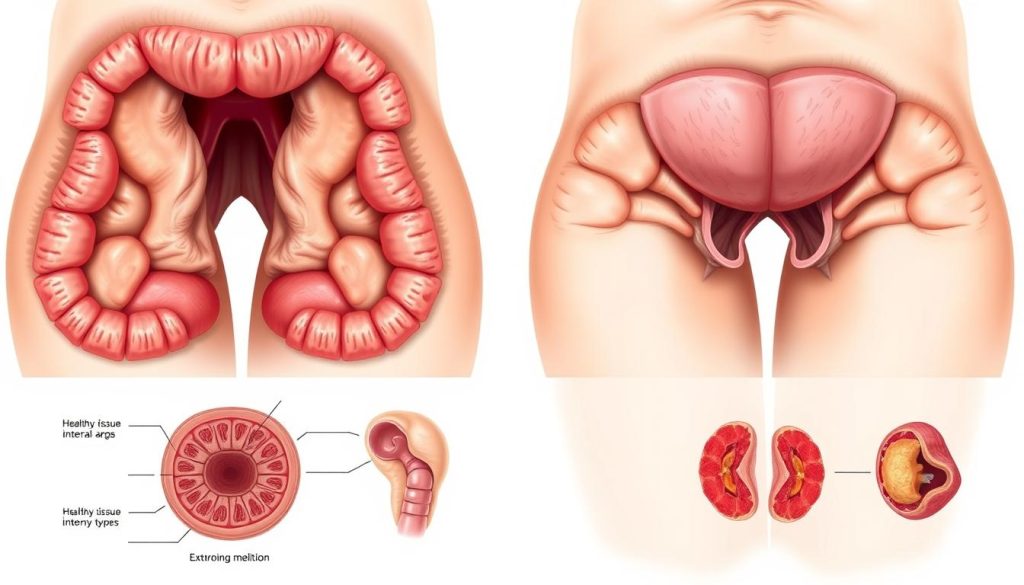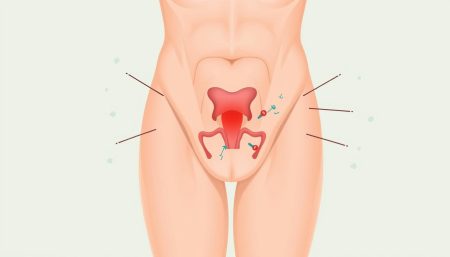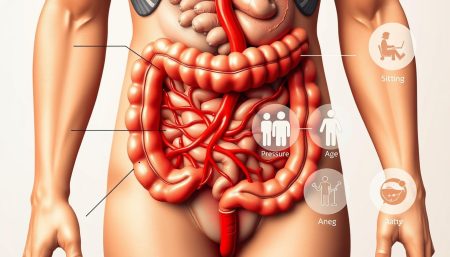Understanding your body’s changes and symptoms is key to good health. Hemorrhoids are common but often misunderstood. This guide helps you identify hemorrhoids visually and be a good hemorrhoid identification guide.
Knowing how to spot them can help with self-care and talking to doctors. It’s all about being informed.
Spotting hemorrhoids can be tricky, especially since symptoms can look like other issues. But, with a good visual guide to hemorrhoids, you can tell them apart. This guide will show you how to spot the signs that mean you need to see a doctor.
Key Takeaways
- Gain essential knowledge on visually identifying characteristics of hemorrhoids.
- Understand the importance of differentiating between types of hemorrhoids.
- Recognize the value of an accurate visual guide in managing personal health.
- Acquire the confidence to discuss symptoms with healthcare providers effectively.
- Learn when visual signs indicate the need for medical consultation.
Introduction to Hemorrhoids and their Visibility
Hemorrhoids are swollen veins in the lower rectum and anus. Their location makes them easy to see, especially when they flare up. Spotting them early helps manage the condition better.
The visibility of hemorrhoids depends on where they are and how bad they are. Inflammation and external hemorrhoids make them stand out. This makes it easier to spot their hemorrhoid features.
Knowing how to spot hemorrhoids is key. External ones look like lumps near the anus. They might be blue because of blood clots, helping you spot them.
- Inflammation causes swelling and redness around the anus.
- Swollen veins outside the rectum, especially in external hemorrhoids.
- Pain, itching, and discomfort that come with the visual signs.
| Feature | Description | Related to Visibility |
|---|---|---|
| Color | Red, blue or purple | Shows the type and how bad they are |
| Location | External (near anal opening), Internal (inside the rectum) | External is more visible, Internal less unless it’s prolapsed |
| Size | Ranges from small, pea-sized to large, swollen masses | Bigger hemorrhoids are easier to see |
By knowing what hemorrhoids look like, you can manage them better. Spotting them early helps avoid bigger problems. It also means you can get help sooner.
Understanding the Types of Hemorrhoids
Knowing the different types of hemorrhoids is key to treating them right. This part explains the look and feel of internal and external hemorrhoids. It also talks about the differences between prolapsed and thrombosed ones.
Internal Hemorrhoids and Their Signs
Internal hemorrhoids are usually hidden but show signs when they come out. Internal hemorrhoids visibility goes up when they pop out, showing as red, moist bulges. These are usually painless unless they get complicated.
External Hemorrhoids Defined
External hemorrhoids are easy to see and can hurt. They show up as swellings around the anus. The external hemorrhoid appearances range from small bumps to big, inflamed ones. These can hurt a lot, especially when you move or go to the bathroom.
The Differences Between Prolapsed and Thrombosed Hemorrhoids
Prolapsed and thrombosed hemorrhoids look and feel different. Prolapsed ones are internal hemorrhoids that come out but can go back in on their own. Thrombosed ones are external hemorrhoids with a blood clot. They are hard, blue, and very painful, needing doctor help.
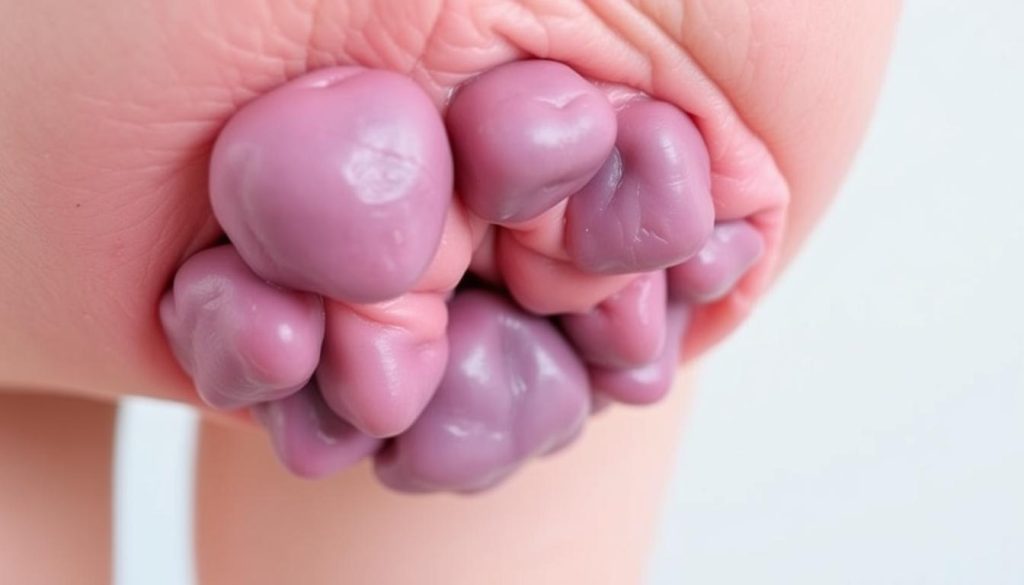
| Type | Appearance | Common Symptoms |
|---|---|---|
| Internal | Not visible, unless prolapsed | Painless bleeding, protrusion during bowel movements |
| External | Visible lumps around the anus | Pain, discomfort, itching |
| Prolapsed | Reddish, moist bulges outside the anal canal | Reversible retraction, discomfort |
| Thrombosed | Bluish, hard lump | Severe pain, inflammation |
Identifying Hemorrhoids Visually: Key Features
Spotting hemorrhoids means looking at the veins closely. Knowing the color and shape helps tell them apart from other issues.
Color Indicators of Hemorrhoids
Hemorrhoid color can tell you a lot. They usually look pink to dark red. But, thrombosed ones might show up blue or purple because of clots. These colors help figure out how bad they are.
Shape and Size: Characteristics to Observe
Hemorrhoids come in different sizes and shapes. They can be small bumps or bigger, longer ones near the anus. Knowing this helps judge how serious they are.
| Color | Shape | Size |
|---|---|---|
| Pink to red | Round to elongated | Small to large |
| Blue to purple (Thrombosed) | Irregular, swollen | Varies, usually larger |
Watching for these signs helps catch hemorrhoids early. This makes managing them easier and improves health.
What Do Hemorrhoids Look Like: Recognizing Symptoms
Spotting hemorrhoid visual symptoms early is crucial for quick relief. Knowing these signs helps you get medical help sooner. This can also reduce your stress and worry. Here are the main symptoms of hemorrhoids to help you spot them quickly.
- Bleeding during or after bowel movements, often noticeable on toilet paper or in the toilet bowl.
- Itching or irritation around the anal region, potentially leading to discomfort.
- A palpable lump near the anus, which might be sensitive or painful.
- Pain or discomfort around the anal area, particularly during or after sitting.
- Swelling around the anus, sometimes accompanied by a feeling of fullness.
Seeing these symptoms can be scary, but knowing they’re common helps. Hemorrhoids are not rare, and they can be managed with the right care.
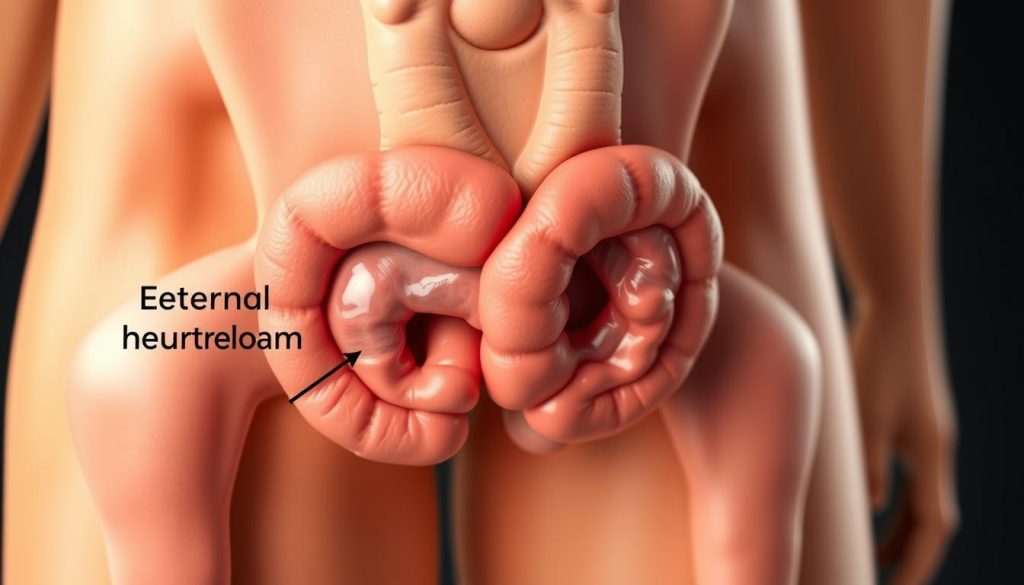
Symptoms like these can mean you have hemorrhoids. Don’t ignore them. Early treatment can make you feel better faster.
Seeing these signs doesn’t mean you have a big problem. But, it’s important to take any changes in your body seriously. Early action can make recovery quicker and easier.
Physical Characteristics of Hemorrhoids
Understanding hemorrhoids can help you recognize this common condition. By looking at the texture of hemorrhoids and their consistency, you can learn about your health. This knowledge is useful for talking to your doctor.
Texture and Consistency of Hemorrhoidal Tissue
The texture of hemorrhoids changes based on the type and stage. They usually feel soft and spongy because they are swollen. But, if they get a blood clot, they become firmer and harder to feel.
Knowing these textures helps you choose the right treatment. It also lets you track if the hemorrhoids are getting better or worse.
Symptoms Accompanying the Visual Signs
Accompanying symptoms of hemorrhoids are also important for diagnosis and treatment. Symptoms include discomfort, itching, and pain, especially when you have a bowel movement. Bleeding is a common sign when the tissue gets too strained.
Seeing the connection between symptoms and physical traits is key. It helps you know when to seek medical help quickly.
Knowing both visual signs and symptoms is crucial. Each detail, from the texture of hemorrhoids to their consistency and symptoms, helps you spot issues early. This way, you can get the right care without waiting.
Visual Appearance of Hemorrhoidal Veins
Knowing how to spot hemorrhoidal veins is key for early treatment. These veins can swell and become more visible. This makes spotting hemorrhoid veins a crucial step in catching the condition early.
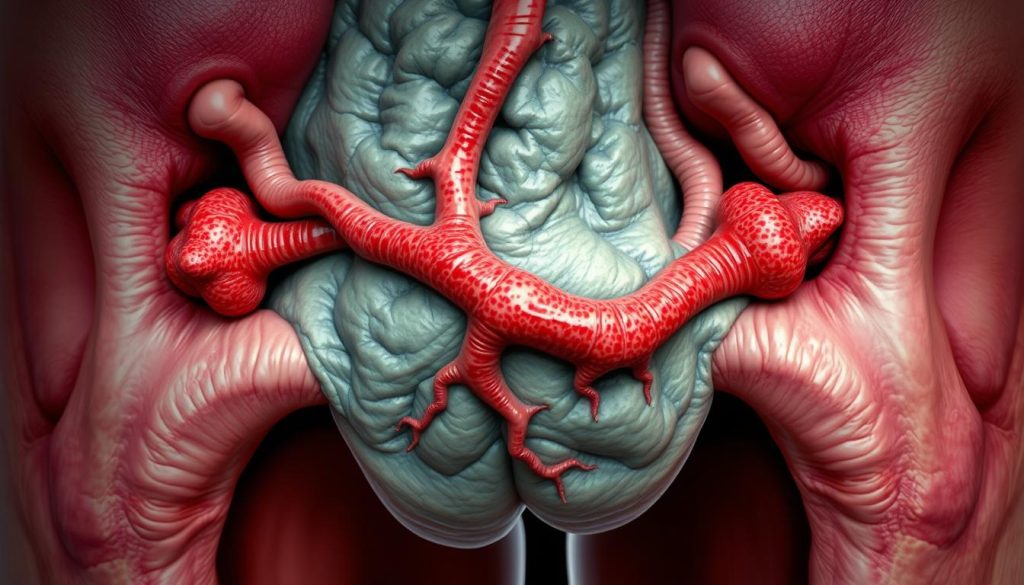
- They appear as bulging, bluish structures near the anus.
- During flare-ups, they swell and become more noticeable.
- The severity and visibility of these veins grow with straining or pressure.
Spotting these signs early can help in treating hemorrhoids quickly. Knowing how to identify these symptoms is important for health monitoring and doctor visits. Keeping an eye on changes in hemorrhoidal veins is a proactive step towards managing the condition.
Hemorrhoid Appearances in Different Stages
Understanding the stages of hemorrhoid development is key for proper diagnosis and management. This section shows how they progress from early to advanced stages. It highlights the visual differences and symptoms at each stage.
Early Stage Hemorrhoids Representation
At the start, the early signs of hemorrhoids are subtle but important. People might feel slight itching, discomfort, or minor swelling around the anus. These signs should prompt further observation and possible early treatment.
Advanced Hemorrhoids and Enhanced Visual Cues
As hemorrhoids get more advanced, advanced hemorrhoid identification becomes clearer. Symptoms like pronounced swelling, discoloration, and protrusion are common. The pain and discomfort also get worse.
| Stage | Description | Visual Cues |
|---|---|---|
| Early | Minimal swelling, occasional discomfort | Mild redness, slight protrusion |
| Intermediate | Regular discomfort, increased swelling | Bright redness, obvious enlargement |
| Advanced | Severe pain, large protrusions | Dark red to purple, significant protrusion |
The transition from early to advanced stages can vary. Recognizing these changes is crucial for timely and effective treatment. Being aware and acting early is important for managing hemorrhoids’ impact on quality of life.
Comparing Hemorrhoid Features to Other Anal Conditions
Understanding anal health is key. It’s important to distinguish hemorrhoids from other conditions. This helps people know their symptoms and when to see a doctor. Anal condition comparisons help tell apart common issues like hemorrhoids, fissures, and abscesses.
Knowing the unique signs of each condition helps avoid wrong diagnoses. This leads to better treatments. Here’s a comparison to show the differences between hemorrhoids and other common anal problems.
| Condition | Appearance | Symptoms | Typical Location |
|---|---|---|---|
| Hemorrhoids | Swollen, reddish vascular structures | Bleeding, discomfort, itching | Inside the rectum or under the skin around the anus |
| Anorectal Abscesses | Pus-filled swellings | Severe pain, fever, redness | Near the anus or rectum |
| Anal Fissures | Small tears in the lining of the anus | Sharp pain during bowel movements | At or just inside the anus |
By observing and comparing these conditions, people can better understand their symptoms. Knowing when to see a doctor is crucial. Professional diagnosis is vital for proper treatment.
Visual Signs of Hemorrhoids in Varied Demographics
Knowing how hemorrhoids look in different groups helps catch them early. This knowledge helps in making prevention and treatment plans better. It’s all about hemorrhoids and age, and gender differences in hemorrhoids.
Does Age Affect the Appearance of Hemorrhoids?
Age plays a big role in how hemorrhoids show up. Older people often have more noticeable symptoms. This is because their connective tissue in the anal area gets weaker.
They might have bigger, more bulging hemorrhoidal veins. These veins are often more lasting and can lead to bigger problems.
Gender-Specific Hemorrhoidal Characteristics
Men and women show hemorrhoids in different ways. For example, pregnant women are more likely to get them. This is because of the extra pressure and hormonal changes they go through.
This can cause swelling and a noticeable red color around the anus.
To learn more about how different factors affect these conditions, check out this article. It talks about common causes of health issues. It shows how certain groups might face different challenges.
Recognizing Hemorrhoids by Sight: When to Seek Medical Opinion
Knowing when to get medical help for hemorrhoids is key. Mild symptoms can be treated at home. But, recognizing serious hemorrhoid symptoms is vital. They might show a bigger health problem.
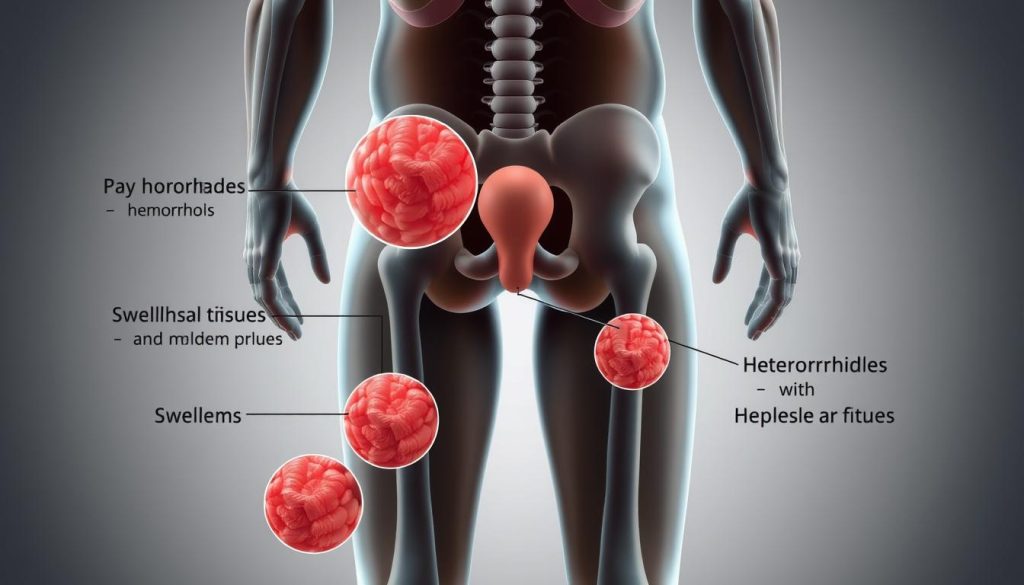
Recognizing serious hemorrhoid symptoms means looking for big changes. This includes color, size, or bleeding changes. These signs need quick doctor visits.
They can prevent serious issues like anemia or strangulated hemorrhoids. These need fast treatment.
- Persistent external bleeding or blood clots
- Severe and uncontrollable pain
- Changes in color to blue or purple
- Significant increase in swelling
Any of these symptoms, especially if they come on suddenly, mean it’s time to see a doctor. Early help can make symptoms better and prevent more problems.
Being quick to notice serious hemorrhoid symptoms helps a lot. It makes treatment easier and less painful. Always see a doctor if you have these symptoms or if home care doesn’t work.
Even though hemorrhoids are common, your health is unique. Getting help when you need it is very important.
Hemorrhoid Visual Symptoms: A Photographic Overview
Knowing how to spot hemorrhoids early is key. A hemorrhoid photo guide is very helpful in identifying hemorrhoids visually. This guide shows pictures of different stages and types of hemorrhoids.
Looking at pictures of hemorrhoids can make symptoms clearer. It helps people understand what they see and why a doctor’s check is important.
| Stage | Description | Image Reference |
|---|---|---|
| Early | Slight swelling around anus, minimal discomfort | Fig. 1 |
| Moderate | Noticeable protrusion, increased irritation | Fig. 2 |
| Advanced | Significant protrusion, severe pain, possible bleeding | Fig. 3 |
Using a hemorrhoid photo guide is crucial for identifying hemorrhoids visually. It shows what hemorrhoids look like and how they progress. Always see a doctor for a proper diagnosis and treatment.
Potential Misconceptions in Identifying Hemorrhoids
It’s key to clear up misconceptions about hemorrhoids for accurate hemorrhoid identification. Many think hemorrhoids are always visible as lumps. But, internal hemorrhoids are often hidden deeper in the anal canal.
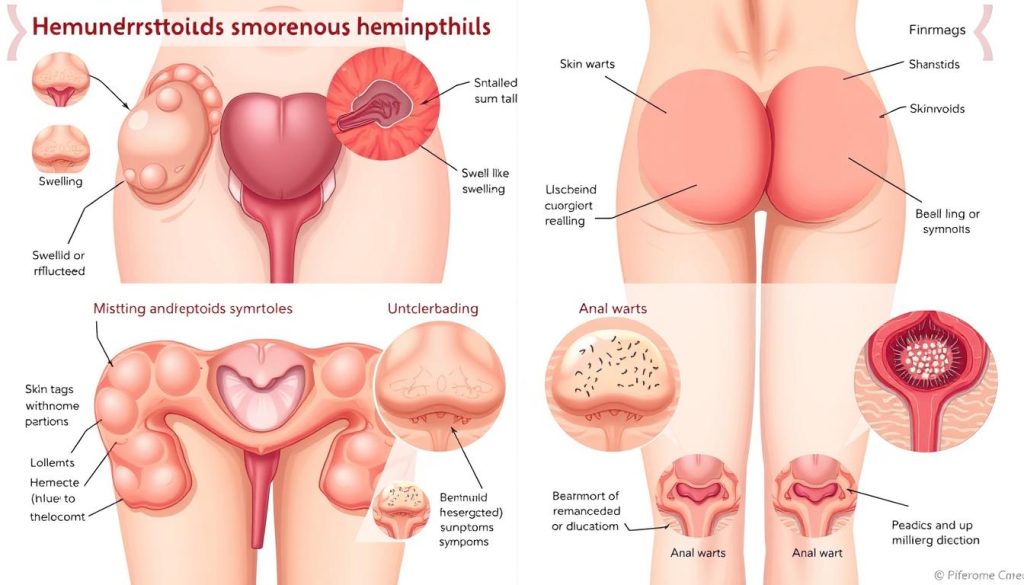
Not all anal discomfort means you have hemorrhoids. Other issues like fissures, abscesses, or infections can cause similar symptoms. Knowing these differences is crucial for both individuals and doctors to make the right diagnosis.
For more insights into debunking myths associated with hemorrhoids, consider the detailed explanations at this resource.
Not every bump or pain near the anus is a hemorrhoid. Accurate hemorrhoid identification requires a thorough medical evaluation to rule out other potential issues.
- Visibility: Internal hemorrhoids may not be visible, contrary to the common belief that all hemorrhoids can be seen.
- Symptoms: Similar symptoms may arise from completely different conditions.
- Self-diagnosis: Self-diagnosing based on internet research or assumptions can lead to errors. Professional medical advice is always recommended.
This guidance aims to shed light and prevent common mistakes linked to misconceptions about hemorrhoids. It encourages those affected to get proper advice and treatment.
Conclusion
In this guide, we’ve explored hemorrhoids in depth. We now know how to tell minor issues from real hemorrhoids. It’s key to remember that while signs can help, a doctor’s check is essential.
This article covered the different types and stages of hemorrhoids. We learned about their typical looks and how they vary by age and gender. This knowledge helps us understand our health better.
Let’s use this information to take care of our health. If symptoms don’t go away, see a doctor. With this guide and medical help, we can manage and ease hemorrhoid pain.
FAQ
Q: What are the visual signs of hemorrhoids?
A: Hemorrhoids show up as swollen, reddish tissues around the anus, especially when they prolapse. You can see external hemorrhoids as swollen bumps or lumps around the anal opening. Thrombosed hemorrhoids look like hard bluish lumps.
Q: Can you identify hemorrhoids by their color?
A: Yes, hemorrhoids can be pink to deep red in color. Thrombosed hemorrhoids are bluish. The color can hint at the type of hemorrhoid.
Q: What differentiates prolapsed and thrombosed hemorrhoids visually?
A: Prolapsed hemorrhoids are internal and look like reddish tissues that sag outside the anal canal. Thrombosed hemorrhoids are external and appear as hard, bluish lumps that hurt a lot.
Q: How do the texture and consistency of hemorrhoids vary?
A: Hemorrhoids can feel soft and spongy or hard. Soft ones are usually not thrombosed. Hard ones might be thrombosed.
Q: Are there specific hemorrhoid features that indicate an advanced stage?
A: Advanced hemorrhoids show more swelling, color changes, and protrusion. They also have more severe pain or bleeding.
Q: How can you distinguish hemorrhoids from other anal conditions?
A: Hemorrhoids look like swellings or lumps at the anal opening. They can be confused with fissures or abscesses. But fissures are small tears, and abscesses have purulent discharge and infection, unlike hemorrhoids.
Q: Does the appearance of hemorrhoids change with age or between genders?
A: Older people may have more visible external hemorrhoids due to skin laxity. Gender differences are not clear, but hormonal changes in women during pregnancy can make symptoms worse.
Q: When should you seek medical opinion for hemorrhoids?
A: See a doctor for severe symptoms like a lot of pain, bleeding, or sudden changes in hemorrhoid appearance. If home remedies don’t help, get professional advice.
Q: Can you identify hemorrhoids through photographs?
A: Yes, comparing your observations with medical photos can help understand hemorrhoid appearance and stages. But, always confirm diagnosis with a healthcare professional.
Q: What are common misconceptions in identifying hemorrhoids?
A: Some think all hemorrhoids are visible lumps and that any anal discomfort is due to them. Knowing the different appearances and symptoms of hemorrhoids is key.












